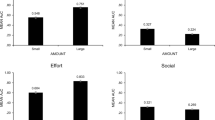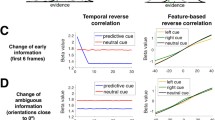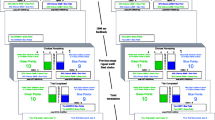Abstract
This study attempted to explicate some of the variables underlying preference, pleasure, and reward. In order to accomplish this, Jones's (1966, 1969) information drive theory, Berlyne's (1967, 1971, 1973, 1978) optimal arousal potential theory, Helson's (1964, 1966, 1971, 1973) adaptation-level theory, and McClelland and Clark's (1953) discrepancy hypothesis were experimentally contrasted. Subjects (316) rated the hedonic tone, perceived uncertainty, arousing properties, and interest value of two series of visual stimuli of specified uncertainty. Regression analyses revealed that immediately prior experience with stimuli varying in uncertainty affected rating of perceived uncertainty and arousing properties but had no major effects on ratings of hedonic tone and interest value. The results did not support Jones's and McClelland and Clark's models. Berlyne's model seemed to account for the affective hedonic tone and interest results, while Helson's model best explained the nonaffective perceived uncertainty and arousal data. It was concluded that nonaffective variables are affected by short-term experience with uncertainty while affective variables are not. Speculations concerning the phenomenon of interest value were then offered.
Similar content being viewed by others
References
Appley, M. H. (Ed.). (1971).Adaptation-level theory: A symposium. New York: Academic Press.
Baldwin, J. M. (1911).Dictionary of philosophy and psychology. New York: Macmillan.
Beebe-Center, J. G. (1966).The psychology of pleasantness and unpleasantness. New York: Russel. (Originally published 1932).
Berlyne, D. E. (1967). Arousal and reinforcement. In D. Levine (Ed.),Nebraska symposium on motivation, 1967. Lincoln: University of Nebraska Press.
Berlyne, D. E. (1971).Aesthetics and psychobiology. New York: Appleton-Centry-Crofts.
Berlyne, D. E. (1973). The viscissitudes of aplopathematic and the thelematoscopic pneumatology (or the hydrography of hedonism). In D. E. Berlyne & K. B. Madsen (Eds.),Pleasure, reward, preference. New York: Academic Press.
Berlyne, D. E. (1974a). Information and motivation. In A. Silverstein (Ed.),Human communication: Theoretical explorations. Washington, D.C.: Erlbaum.
Berlyne, D. E. (Ed.). (1974b).Studies in the new experimental aesthetics. New York: Wiley.
Berlyne, D. E. (1978). Curiosity and learning.Motivation and Emotion, 2 97–176.
Brickman, P., Coates, D., & Janoff-Bullman, R. (1978). Lottery winners and accident victims: Is happiness relative?Journal of Personality and Social Psychology, 36 917–927.
Cohen, J., & Cohen, P. (1975).Applied multiple regression/correlation analysis for the behavioral sciences. New York: Wiley.
Crozier, J. B. (1971). Information theory and melodic perception: In search of the aesthetic engram. In H. I. Day (Ed.),Advances in intrinsic motivation and aesthetics. New York: Plenum Press.
Day, H. I. (1977). In memoriam: Daniel Ellis Berlyne.Motivation and Emotion, 1 377–383.
Haber, R. N. (1958). Discrepancy from adaptation level as a source of affect.Journal of Experimental Psychology, 56 370–375.
Hare, F. G. (1974). Artistic training and responses to visual and auditory patterns varying in uncertainty. In D. E. Berlyne (Ed.),Studies in the new experimental aesthetics. New York: Wiley.
Helson, H. (1947). Adaptation-level as a frame of reference for predictions of psychophysical data.American Journal of Psychology, 60 1–29.
Helson, H. (1948). Adaptation-level theory as a basis for a quantitative theory of frames of reference.Psychological Review, 55 297–313.
Helson, H. (1964).Adaptation-level theory. New York: Harper & Row.
Helson, H. (1966). Some problems in motivation from the point of view of the theory of adaptation level. In D. Levine (Ed.),Nebraska symposium on motivation. Lincoln: University of Nebraska Press.
Helson, H. (1971). Adaptation-level theory: 1970 and after. In M. H. Appley (Ed.),Adaptation-level theory: A symposium New York: Academic Press.
Helson, H. (1973). A common model for affectivity and perception: An adaptation-level approach. In D. E. Berlyne & K. B. Madsen (Eds.),Pleasure, reward, preference. New York: Academic Press.
Hull, C. L. (1943).Principles of behavior. New York: Appleton-Century-Crofts.
Jones, A. (1961). Supplementary repor: Information deprivation and irrelevant drive as a determinant of an instrumental response.Journal of Experimental Psychology, 62 310–311.
Jones, A. (1964). Drive and incentive variables associated with the statistical properties of sequences of stimuli.Journal of Experimental Psychology, 67 423–431.
Jones, A. (1966). Information deprivation in humans. In B. A. Maher (Ed.),Progress in experimental personality research (Vol. 3). New York: Academic Press.
Jones, A. (1969). Stimulus-seeking behavior. In J. P. Zubek (Ed.),Sensory deprivation: Fifteen years of research. New York: Appleton-Century-Crofts.
Jones, A., & McGill, D. (1967). The homeostatic character of information drive in humans.Journal of Experimental Research in Personality, 2 25–31.
Jones, A., Wilkinson, H. J., & Braden, I. (1961). Information deprivation as a motivational variable.Journal of Experimental Psychology 62 126–137.
Leckart, P. F., Glanville, B., Hootstein, E., Kleman, K., & Yaremko, R. M. (1972). Looking time, stimulus complexity, and the perceptual deprivation effect.Psychonomic Science, 26 107–108.
Leckart, B. F., Levine, J. R., Goscinski, C., Brayman, W. (1970). Duration of attention: The perceptual deprivation effect.Perception and Psychophysics, 7 163–164.
McClelland, D. C., Atkinson, J. W., Clark, R. A., & Lowell, E. L. (1966). The affective arousal model of motivation. In R. N. Haber (Ed.),Current research in motivation. New York: Holt, Rinehart & Winston.
McClelland, D. C., & Clark, R. A. (1953). Discrepancy hypothesis. In D. C. McClelland, J. W. Atkinson, R. A. Clark, & E. L. Lowell (Eds.),The achievement motive. New York: Appleton-Century-Crofts.
Nicki, R. M., & Moss, U. (1975). Preference for nonrepresentational art as a function of various measures of complexity.Canadian Journal of Psychology, 29 237–249.
O'Mahony, M. O. (1979). Salt taste adaptation: The psychophysical effects of adapting solution and residual stimuli from prior tasting on the taste of sodium chloride.Perception, 8 441–476.
Shannon, C. E. (1948). A mathematical theory of communication.Bell System Technical Journal, 27 379–423, 623–656.
Shannon, C. E., & Weaver, W. (1949).Mathematical theory of communication. Urbana: University of Illinois Press.
Spence, K. W. (1956).Behavior theory and conditioning. New Haven: Yale University Press.
Suedfeld, P. (1981). Environmental restriction and stimulus hunger. In H. I. Day (Ed.),Advances in intrinsic motivation and aesthetics. New York: Plenum Press.
Terwilliger, R. F. (1963). Pattern complexity and affective arousal.Perceptual and Motor Skills, 17 187–195.
Thayer, R. E. (1967). Measurement of activation through self-report.Psychological Reports, 20 663–678. (Monograph Supplement 1-V20)
Thayer, R. E. (1970). Activation states as assessed by verbal report and four psychophysiological variables.Psychophysiology, 7 86–94.
Thayer, R. E. (1978). Toward a psychological theory of multidimensional activation (arousal).Motivation and Emotion, 2 1–34.
Thomas, D. R. (1974). Adaptation level in stimulus generalization. In G. Bower (Ed.),The psychology of learning and motivation. New York: Academic Press,8, 91–146.
Thomas, H. (1971). Discrepancy hypotheses: Methodological and theoretical considerations.Psychological Review, 78 249–259.
Vernis, J. S. Brandsma, J. M., & Cofer, C. N. (1968). Discrepancy from expectations in relation to affect and motivation: Tests of McClelland's hypothesis.Journal of Personality and Social Psychology, 9 47–58.
Vitz, P. C. (1966a). Affect as a function of stimulus variation.Journal of Experimental Psychology, 71 74–79.
Vitz, P. C. (1966). Preference for different amounts of visual complexity.Behavioral Science, 11 105–114.
Walker, E. L. (1980a). Berlyne's theoretical contributions to psychology.Motivation and Emotion, 4 105–111.
Walker, E. L. (1980b).Psychological complexity and preference: A hedgehog theory of behavior. Monterey, California: Brooks/Cole.
Walker, E. L. (1981). The quest for the inverted U. In H. I. Day (Ed.),Advances in intrinsic motivation and aesthetics. New York: Plenum Press.
Weinberger, J. L. (1982).Reactions to uncertainty: A comparison of three motivational theories. Unpublished doctoral dissertation, New School for Social Research.
Wiener, N. (1948).Cybernetics. New York: Wiley.
Winer, B. J. (1971).Statistical principles in experimental design (2nd ed.). New York: McGraw-Hill.
Author information
Authors and Affiliations
Additional information
Jewish Child Care Association
This article is based on a dissertation submitted to the New School for Social Research in partial fulfillment of the Ph.D. requirements. I would like to thank Drs. Nathan Brody and Nathan Kogan for their help in conducting this experiment and preparing this article.
Rights and permissions
About this article
Cite this article
Weinberger, J. Reactions to uncertainty: A comparison of three motivational theories. Motiv Emot 8, 109–140 (1984). https://doi.org/10.1007/BF00993069
Issue Date:
DOI: https://doi.org/10.1007/BF00993069




